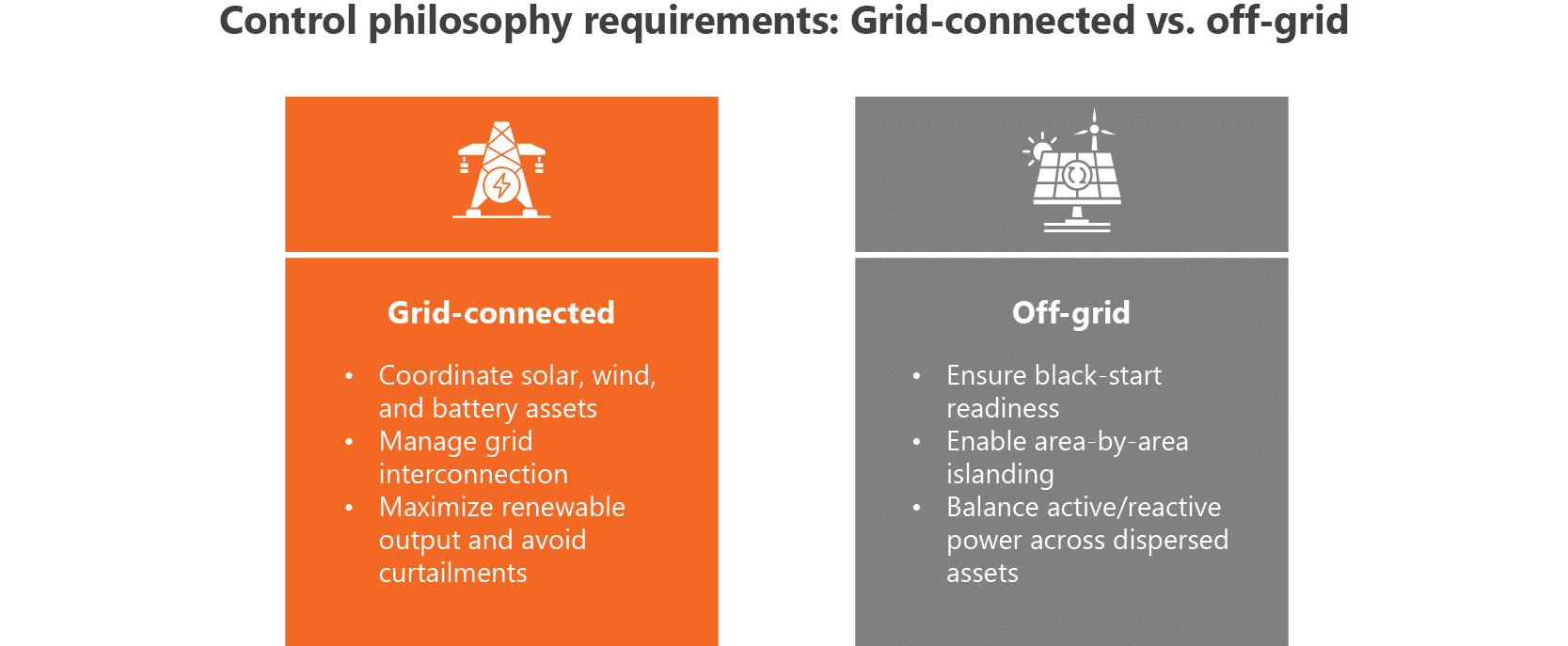5-minute read
Quick summary: How a clear control philosophy enables microgrid resilience and efficiency
Driven by demands for resilience, sustainability, and autonomy, the adoption of microgrids is accelerating across industries. Yet many projects encounter setbacks not in hardware, but in logic. Control philosophies, often treated as a downstream concern, are central to operational success.
A well-designed control philosophy defines how energy is managed, how contingencies are addressed, and how assets interact within a unified system. Without this structure, even advanced microgrids can struggle to deliver stable, efficient performance.
As organizations deploy microgrids to meet increasingly sophisticated energy goals, a system-wide control philosophy has become a foundational requirement for reliable, scalable operations.
Article continues below.
WEBINAR
Harnessing the power of DERMS: Enhancing the grid’s flexibility and reliability
Access “Harnessing the power of DERMS” on demand to learn:
- How DERMS can optimize grid performance by balancing generation, storage, and consumption
- Differences between grid-centric and grid-edge approaches and how they work together
- Real-world use cases and success stories of DER orchestration to enhance grid stability and efficiency
We will never sell your data. View our privacy policy here.
Real-world complexity: Two case study snapshots
Recent projects in two very different environments offer a clear view into the value of a strong control philosophy.
In the first case, although the system had access to an external grid, the priority was to maximize use of onsite renewables and storage while minimizing imports and avoiding exports. The control strategy had to:
- Coordinate solar, wind, and battery assets
- Manage grid interconnection
- Maximize renewable output and avoid curtailments
The second case involved an off-grid microgrid capable of supporting 24/7 operations across multiple facilities. With no external grid to fall back on, reliability hinged on the seamless orchestration of solar generation, battery storage, and backup diesel generation. In this case, the client’s control strategy needed to:
- Ensure black-start readiness
- Enable area-by-area islanding
- Balance active/reactive power across dispersed assets
Though their objectives differed—one optimizing for cost and production, the other for resilience and autonomy—both projects revealed a common thread: A high-level control philosophy, designed to unify systems and align stakeholders, is key to reliable microgrid performance.

What is a microgrid control philosophy?
A microgrid control philosophy is a strategic blueprint for how distributed energy resources (DERs) function together within a self-contained system. The control philosophy outlines the principles, priorities, and interdependencies that govern system behavior under varying conditions. It specifies how the system
- Manages active and reactive power
- Handles contingencies
- Transitions between grid-connected and islanded modes
This framework also provides the logic behind energy dispatch, source prioritization, and recovery after outages.
Unifying diverse assets
Microgrids often combine solar PV, battery storage, internal combustion engines, and power electronics like STATCOMs. Each component has its own control logic and vendor-specific features.
The control philosophy brings these assets into coordinated operation, clarifying when and how each activates, communicates, balances load, and contributes to stability. Without it, even high-quality components can conflict or underperform.
Strategic guidance vs. controller specifications
Controller specifications detail how individual devices operate—setpoints, response times, communication protocols. The control philosophy defines how those specs align across the system.
Whereas a specification might set how quickly a battery discharges, the philosophy defines when, why, and under what conditions that action occurs. This system-level view enables integrated operation, clear testing criteria, and smoother commissioning.
The control gap: Why projects falter without a plan
Delaying the development of a control strategy can lead to costly consequences, particularly in complex or multi-vendor environments.
Misaligned vendors, fragmented systems
Without a unifying control strategy, vendors may make conflicting assumptions about roles and responsibilities. This situation often leads to duplication, control gaps, or operational inconsistencies that compromise system performance.
Late-stage surprises and instability
Control issues often surface during final testing, when it’s expensive and time-consuming to resolve them. Assets may not respond as expected, forcing reconfiguration or redesign under pressure.
Commissioning slowdowns
Projects frequently stall at the finish line due to missing or unclear documentation. Without a shared operational blueprint, teams struggle to validate behaviors, leading to inefficient testing cycles and delayed go-live milestones.
Design for context: Islanded vs. grid-connected strategies
Each microgrid requires a tailored control strategy, depending on whether it operates independently or in coordination with a traditional grid.
Distinct requirements, different risks
Isolated microgrids must regulate power autonomously, placing primary responsibility on local assets for maintaining grid stability. In our off-grid case, the control philosophy defined how the battery energy storage system (BESS), acting as the primary frequency controller, interacted with the microgrid controller, which provided secondary frequency regulation. This coordination was critical to maintaining frequency, managing black starts, prioritizing loads, and ensuring reliability across distributed nodes.
Grid-connected microgrids focus on cost efficiency, import/export optimization, and seamless transitions. In our grid-connected example, the system dynamically prioritized on-site generation while managing grid interconnection.
Planning for the unpredictable
Operational readiness is a core function of the control philosophy. It must account for planned maintenance, equipment downtime, and N-1 generation contingencies, ensuring the system can operate safely and stably even when a key asset is offline. This planning includes coordinating asset availability, load coverage, and fallback strategies during routine operations or infrastructure changes.
Contingency planning remains essential for unplanned events—such as feeder trips, asset failures, or energy shortfalls. The control strategy should define automated responses and prioritize critical functions to maintain grid integrity during disruptions.
Black-start planning plays a central role. In an isolated scenario, the microgrid must be capable of self-recovery, typically starting with BESS or prewarmed engines and scaling up to energize larger segments. In grid-connected environments, the strategy may involve coordination with utility operators and phased restoration across zones.
Synchronization logic—ensuring voltage, frequency, and phase alignment before reconnection—is equally essential. A well-defined control strategy outlines the criteria, timing, and authority for these actions to minimize risk and downtime.
Strategy tradeoffs in the field
Design choices often balance resilience against cost. Remote sites may invest in redundancy, while urban facilities may prioritize economic dispatch. The control strategy must reflect those priorities.
Crafting a future-ready control philosophy
A forward-looking control philosophy supports long-term adaptability, not just near-term functionality.
Adapting to real-time conditions
Short-term forecasting and economic dispatch help systems respond to shifting conditions. In our grid-connected project, dispatch logic adjusts every five minutes to balance production demands and available resources. Load prioritization ensures critical functions remained powered even under constraints.
Planning for expansion
Microgrids rarely stand still. We designed the off-grid project with flexibility to accommodate future features that significantly increase the system’s load. A scalable control philosophy anticipates expansions, enabling new assets to be added without disrupting core logic.
Enabling systems to work together
Vendor diversity is the norm. A well-structured control philosophy ensures cross-platform communication, standardized data exchange, and clear sequencing of actions, reducing integration risk and long-term maintenance costs.
From complexity to clarity: A structured approach
At Logic20/20, we work with clients to turn complexity into coordinated action. Our methodology delivers clarity and control from the earliest phases of a project.
A phased methodology that builds alignment early
We begin with resource and requirement assessment, document aggregation, and system role definition. From there, we build a roadmap for active/reactive power management and contingency response, documented in a control philosophy that guides the project through design, testing, and commissioning.
Coordinating across stakeholders and vendors
We act as a central coordination layer, bridging gaps between OEMs, integrators, and project teams. By clarifying roles and resolving interface conflicts early, we reduce risk and accelerate timelines.
Why early engagement matters
Engaging system-level experts early prevents logic conflicts, reduces rework, and ensures assets are integrated into a coherent system from the outset. This early involvement is also critical for assessing and defining the hierarchy of control schemes across all controllers—such as PV inverters, BESS controllers, and microgrid supervisory systems—to ensure consistent logic, clear authority, and stable interactions under all operating conditions.
Where vision meets execution
Microgrids are transforming how organizations achieve energy resilience and sustainability. This transformation depends not just on the technologies deployed, but on the strategy guiding them. A strong control philosophy connects hardware to outcomes, aligning energy systems with operational priorities and long-term goals.
For organizations investing in microgrids, clarity of control is where strategy becomes reality.

Powering a sustainable tomorrow
We partner with utilities to help them build a more resilient grid and move towards a cleaner, brighter future through
- AI-driven automation
- Asset image analytics
- DERMS implementation
- Analytics & predictive insights
- Cloud optimization


Managing Director of Grid Operations Alex Lago has over 30 years of experience in power system operations, wholesale power market operations, SCADA/EMS/GMS/DMS/OMS systems, and system/application design and implementation. He is passionate about advising companies on large-scale transformational projects and implementation of complex real-time operation systems.

